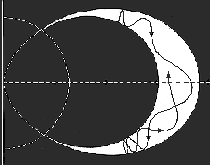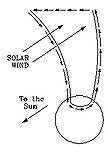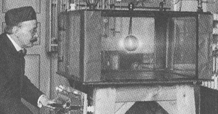Was this a clue why the polar aurora is usually seen only within a limited distance of the magnetic poles?
It indeed was. The French mathematician Henri Poincaré--and 50 years later, in more detail, Hannes Alfvén in Sweden--analyzed the motion of such electrons and concluded that they were guided by magnetic field lines, like beads strung on a wire. From his terrella experiment, Birkeland guessed that the aurora was caused by electrons from the Sun, which were guided by magnetic field lines to the Earth"s polar caps, and produced there a glow as they hit in the upper atmosphere. As it turned out, the Sun was not the source, but the rest of the guess was pretty close to the truth.
The Ring Current
But what about the changes in the Earth's magnetism during a magnetic storm? At such times the magnetic field observed near the equator, anywhere around the Earth, became weaker by about 0.5-1%. This suggested that somehow, during storms, a large electric current circled the Earth above its equator. Scientists named it the "ring current," but no one had an idea at what distance it flowed.
Alfvén's theory suggested how this current could be carried. Charged particles, such as ions or electrons, were not only guided by magnetic field lines, but as they slid along such lines (more accurately, spiralled around them), they were also repelled (in a way) from regions of more intense magnetic field.
 |
| Motion of a Trapped Particle |
Field lines of the Earth, like those of a bar magnet, stretch from the vicinity of one magnetic pole to that of the other, and the magnetic force on each line is weakest halfway between the line's "footpoints" on Earth, in the part where the line is most distant from Earth. Ions and electrons can be trapped in that weak field, bouncing back and forth, turned back each time they try to slide down into the more intense field which exists closer to Earth.
One can show that by secondary processes, such particles also slowly change their attachment from one field line to its next neighbor, gradually circling the globe--clockwise (view from far north) for positive ions, counterclockwise for negative electrons. However, any time negative electrons move one way and positive ions the opposite way, an electric current is created! That was indeed how S.F. Singer in 1957 proposed to explain the existence of a ring current during magnetic storms.
Radiation Belts
In 1958 artificial satellites observed such trapped "radiation belts, " not just temporary belts accompanying magnetic storms, but permanent features of the Earth's magnetic environment in space. In 1959 that environment was named "magnetosphere" by Tom Gold of Cornell University. Two types of belts were found. An inner, small but intense proton belt turned out to be a secondary product of the cosmic radiation, of the diffuse background of high-energy particles which seems to fill our galaxy. But it was the "outer belt" that carried the ring current, a belt of ions and electrons with moderate energy but in large numbers.
 |
| Regions of the Magnetosphere |
The energy source of the ring current and of all its associated phenomena turned out to be the solar wind--a continuous flow of ions and electrons, spreading out in all directions from the Sun's topmost layer, the million-degree hot corona. Magnetic storms arise from unusually fast flows in the solar wind, especially those connected to explosive events associated with active sunspots. The solar wind compresses the magnetic field lines facing it on the day side of the Earth and confines those lines into a rounded cavity. In the opposite direction, on the night side, the same solar wind stretches field lines into a long "magnetotail" and the cavity then becomes a long cylinder.
It is this tail where many active phenomena of the magnetosphere--part of our "space weather"--originate. Of special interest is a thick layer known as the plasma sheet, spread in the region of weak magnetic field which is sandwiched between two bundles of magnetic field lines. One bundle, north of the equator, consists of field lines that head into the vicinity of the north magnetic pole, and the other bundle is its mirror image south of the equator, of field lines directed out of the southern polar cap. The plasma sheet is where ring current particles originate, and where "substorms" shove particles earthward and create bright auroral displays.
The Polar Aurora
In locations such as Fairbanks, Alaska or Tromsö, Norway, the polar aurora is not at all rare. Its bright visible arcs appear to be associated with strong electric currents linking Earth to space. Unlike the ring current, such currents are driven by voltage difference (like currents in the home or in a flashlight).
In space such currents most easily flow along magnetic field lines, because the particles that carry them (mainly electrons) tend to stay attached to such lines. Some flow from space to Earth, some from Earth to space, and near Earth their circuit is completed by a layer in the high atmosphere that conducts electricity well, the E-layer of the Earth"s ionosphere, located some 125 km above ground. The currents do not reach the ground, because air at lower levels is a very good electric insulator.
 |
Solar Wind
Dynamo |
Electric currents, of course, need to flow in a closed circuit, but we are still not sure where or how these circuits close. For some such currents, a popular guess (probably an oversimplification) is that the distant ends of field lines that carry them dip into the solar wind (which can conduct electricity), somewhat like the wires which Faraday dipped into the water below Waterloo bridge (see section on dynamos). This would create a dynamo drawing its energy from the flow of the solar wind.
The polar aurora is created by electrons moving earthward while carrying this current. They gain speed from the driving voltage and after reaching the atmosphere, smash into atoms of oxygen or nitrogen, causing them to emit light. The typical aurora has an eerie greenish glow, emitted by oxygen.
Be aware that all the preceding is a very simplified picture, omitting many details. Unfortunately, a fuller description of the Earth's magnetosphere and its interesting phenomena is entirely beyond the scope of this brief presentation. Much more information can be found in "The Exploration of the Earth's Magnetosphere,"an extensive and thorough (but non-mathematical) exposition.
Next Stop: 17. Planetary Magnetism
Back to the Master List
|



